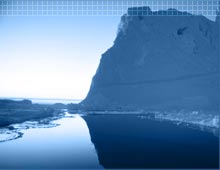 |

Dan Grossman left Boston on Saturday, December 28th for Antarctica.
Throughout his trip, he will be sending in journal entries. Here's
his most recent update:
Sunday December 29, 2002
Boston to New York to Santiago to Punta Arenas
I arrived almost without incident in Santiago, Chile after making
stops in New York and Lima, Peru. An avuncular man named Raul met
me at the Santiago airport, where I had a six-hour layover. He is
part of a four-man team hired that makes sure researchers going
to Palmer Station have smooth connections. Raul ushered me through
immigration and customs to a waiting car.
Raul drove me to the office of Ecoceanos,
a Chilean environmental group where Juan Carlos C�rdenas was waiting
meeting me. C�rdenas explained to me his concerns about the environmental
problems caused by fishing for Chilean Sea Bass, also known as Patagonian
Tooth Fish. This lucrative fish is shipped mostly to markets in the
U.S. and Japan. C�rdenas says the fish is not being sustainably exploited.
The tackle used to catch it, known as long-line equipment, is also
responsible for the death of thousands of sea birds (such as albatross
and southern giant petrel) each year. I'll be posting more about the
Chilean Sea Bass later.
On the way back to the Santiago airport Raul took me on a brief tour.
We passed the elegant Plaza de Armas (central plaza)--ringed with
government buildings and shaded by tall palm trees--and the old Spanish-colonial
neighborhood. Here graceful, low-slung, stucco buildings line the
streets, their ironwork balconies hanging over the sidewalk. At a
rotary on the way back to the airport was a tall, green artificial
Christmas tree covered with ornaments featuring the Coca-Cola logo.
Surrounding the tree are billboards showing a Coca-Cola-slinging Santa.
Raul told me that in other years the tree advertises Pepsi. "I think
it depends on who makes the best offer," he says.
Prior to departing Boston I made an appointment with Jaime Abarca,
a dermatologist at the Punta Arenas Regional Hos`pital. Dr. Abarca
published a journal article last February documenting an increase
in severe sunburns connected with the ozone hole. Ozone keeps most
harmful ultraviolet radiation from reaching Earth. But, due to the
release of chlorofluorocarbons (CFCs), used until recently in air
conditioners and spray cans, the ozone layer was damaged. This damage
is most severe in Antarctica, where a hole now appears each (southern
hemisphere) summer. The hole is centered on Antarctica but it extends
at least as far north as Punta Arenas, where high levels of UV light
can cause sunburns in a matter of minutes. More recently Dr. Abarca
published a study on skin cancer. It is predicted that reduced ozone
levels will increase skin cancer. But it takes 10 to 20 years for
such cancers to appear, so proof that increased UV light (which only
began about 10 or 20 years ago) has caused harmful effects has yet
to appear. Dr. Abarca told me that his most recent study suggests
that in Punta Arenas the long-expected increase is about to occur.
On the way back from Dr. Abarca's office I walked through the Punta
Arenas cemetery, a fascinating detour. Menendez, a sheep baron, who
made a fortune once the largest in South America, is buried in a mausoleum
here. The cemetery is meticulously maintained, including a forest
of column-like topiary. Many graves feature tiny garden plots planted
with flowers and glass-covered dioramas with photos and treasured
objects of the dead. For the less well off there are multi-family-style
crypts.
In mid-afternoon I had appointment with two fishermen, to learn more
about the impact of long-line fishing on fish populations and sea
birds. This style of fishing, which is used to catch Chilean Sea Bass,
uses thousands of hooks strung lines tens of miles long. The baited
hooks sink deep into the ocean where the Chilean Sea Bass live, but
not before albatrosses, giant petrels, penguins and other birds are
attracted. There are ways to reduce the hazard to birds, such as devices
that make the line sink out of their diving range faster, but the
fishermen says none of them are used by Chilean fishermen. They say
the worst offenders are large factory boats, which have lines that
stay near the surface the longest. One of the fishermen tells me what
its like to be reeling in a fish-laden line and to encounter a dead
penguin hooked to the cable.
When I finally board my ship, the R/V Laurence M. Gould in the late
afternoon, the vessel is a beehive of activity. Crew are making last-minute
repairs, strapping cargo down and loading supplies. Tomorrow morning
we set sail for Palmer Station.
Read Dan's previous entry
|



